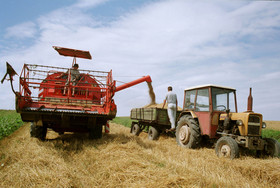Common Agricultural Policy, CAP

- (Photo: Commission)
The Common Agricultural Policy was the first common policy adopted by the EU under the Treaty of Rome of 1958. It was seen as compensation to France for the customs union covering industrial products, which were of special interest to Germany.
The CAP is based on a common internal market for agricultural products, and it provides higher prices than those on the world market. The higher prices are kept competitive through customs duties and agricultural levies on imported agricultural products.
EU export companies receive export restitutions paid from the common EU budget when they sell agricultural products outside the EU. The level of support through restitutions has been halved over recent years. Instead, farmers receive direct payments.
There are more than 5,000 different EU rules governing the exceedingly bureaucratic Common Agricultural Policy. The administration includes several working groups and management committees, with representatives from the Member States, often meeting once a week to fix prices.
Rules are decided by a qualified majority in the Council. This led to the empty chair crisis and the Luxembourg Compromise.
Notes
- In recent years, there have been significant reforms towards a more environment-friendly, market and social policy orientated CAP.
- The EU Parliament has no co-decision for agriculture. It can only be heard through the consultation procedure.
The future
The EU Constitution introduces the co-decision procedure for the Common Agricultural Policy so that the EU Parliament will be able to propose amendments and veto proposed laws. Regulation of prices will remain the competence of the Council, though.
Links
http://europa.eu.int/pol/agr/index_en.htm
http://www.ue2004.ie/templates......ndard.asp?sNavlocator=4,24,318
http://www.europarl.eu.int/factsheets/4_1_9_en.htm
